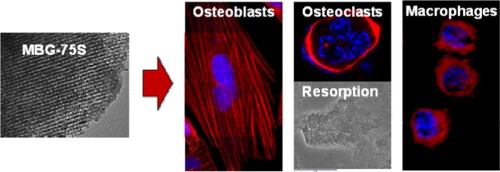Journal of Colloid and Interface Science ( IF 9.9 ) Pub Date : 2018-05-29 , DOI: 10.1016/j.jcis.2018.05.099 N. Gómez-Cerezo , L. Casarrubios , I. Morales , M.J. Feito , M. Vallet-Regí , D. Arcos , M.T. Portolés

|
A mesoporous bioactive glass (MBG) of molar composition 75SiO2-20CaO-5P2O5 (MBG-75S) has been synthetized as a potential bioceramic for bone regeneration purposes. X-ray diffraction (XRD), Fourier transform infrared spectroscopy (FT-IR), nitrogen adsorption studies and transmission electron microscopy (TEM) demonstrated that MBG-75S possess a highly ordered mesoporous structure with high surface area and porosity, which would explain the high ionic exchange rate (mainly calcium and silicon soluble species) with the surrounded media. MBG-75S showed high biocompatibility in contact with Saos-2 osteoblast-like cells. Concentrations up to 1 mg/ml did not lead to significant alterations on either morphology or cell cycle. Regarding the effects on osteoclasts, MBG-75S allowed the differentiation of RAW-264.7 macrophages into osteoclast-like cells but exhibiting a decreased resorptive activity. These results point out that MBG-75S does not inhibit osteoclastogenesis but reduces the osteoclast bone-resorbing capability. Finally, in vitro studies focused on the innate immune response, evidenced that MBG-75S allows the proliferation of macrophages without inducing their polarization towards the M1 pro-inflammatory phenotype. This in vitro behavior is indicative that MBG-75S would just induce the required innate immune response without further inflammatory complications under in vivo conditions. The overall behavior respect to osteoblasts, osteoclasts and macrophages, makes this MBG a very interesting candidate for bone grafting applications in osteoporotic patients.
中文翻译:

介孔生物活性玻璃对成骨细胞,破骨细胞和巨噬细胞的影响
摩尔组成为75SiO 2 -20CaO-5P 2 O 5的中孔生物活性玻璃(MBG)(MBG-75S)已被合成为潜在的生物陶瓷,可用于骨骼再生。X射线衍射(XRD),傅立叶变换红外光谱(FT-IR),氮吸附研究和透射电子显微镜(TEM)表明MBG-75S具有高度有序的介孔结构,具有高表面积和孔隙率,这可以解释其原因。与周围介质的高离子交换速率(主要是钙和硅可溶物质)。MBG-75S与Saos-2成骨细胞样细胞接触时显示出高生物相容性。浓度高达1 mg / ml不会导致形态或细胞周期发生重大变化。关于破骨细胞的作用,MBG-75S允许RAW-264.7巨噬细胞分化为破骨细胞样细胞,但其吸收活性降低。这些结果指出,MBG-75S不抑制破骨细胞生成,但是降低了破骨细胞的骨吸收能力。最后,专注于先天免疫反应的体外研究表明,MBG-75S可使巨噬细胞增殖,而不会诱导其朝着M1促炎表型极化。这种体外行为表明MBG-75S只会在体内条件下诱导所需的先天免疫反应而不会引起进一步的炎症并发症。关于成骨细胞,破骨细胞和巨噬细胞的整体行为,使得该MBG成为骨质疏松患者的骨移植应用中非常有趣的候选者。



























 京公网安备 11010802027423号
京公网安备 11010802027423号